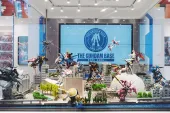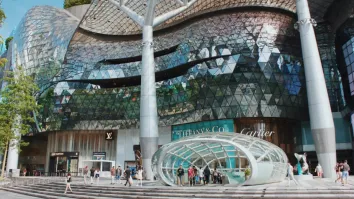Retail to boom in Modi's India
Asia’s third-largest economy, India, showed positive growth last year, sparking hope of a retail boom under the helm of the country’s new Prime Minister, Narendra Modi. Shirish Nadkarni reports.
AS India capped its second straight year with below 5% growth last year, the hopes of reviving Asia’s third-largest economy rested largely on the shoulders of one man — Narendra Modi, the country’s new Prime Minister.
From the common man to domestic and foreign investors, and business tycoons, they all share the belief that the charismatic leader has the magic wand to reverse the poor spell on the country’s economy. However, the task for the new leader will not be an easy one.
Modi inherits an economy with weak growth, persistently high inflationary pressures amid rising food prices, infrastructure bottlenecks, and elevated interest rates.
India’s economy grew by 4.7% in fiscal 2013-14, while industrial output shrank in the closing weeks of the financial year.
Amidst the pressure to revive growth, there is a compelling need to repair government finances to regain the confidence of foreign investors and rating agencies that have been warning of downgrades.
Is this too much to expect from one man?
Yes, there are a lot of expectations on Narendra Modi and the BJP-led National Democratic Alliance (NDA) government as investors’ hope that a change in guard may help turn around the fortunes of a slowing economy.
Modi is committed to ushering in strong economic and structural reforms to boost manufacturing and exports, remove infrastructure deadlocks and attract robust foreign investment to accelerate economic growth.
Modi’s elevation to the top office in the land has coincided with a substantial easing of global petroleum prices that have brought down inflation to much more manageable levels.
Higher levels of disposable income and reduced food costs have combined to fuel a retail boom across the spectrum.
The complex Indian retail sector is one that could benefit from fresh policy initiatives aimed at liberalisation. It is very different from that of developed countries, divided as it is into organised and unorganised sectors.
The organised retail market refers to trading activities carried out by licensed retailers, as also those registered for sales tax, income tax, for example. The organised retailers include corporate funded supermarkets and retail chains, and privately owned gigantic retail businesses.
On the other hand, the unorganised retail market refers to the traditional players of low-cost retailing, for example, the local kirana shops, owner-manned, mom-n-pop general stores, paan/beedi shops, convenience stores, handcart and pavement vendors, and so on.
Unorganised retailing remains the predominant form of trade in India, constituting almost 92% of total trade in the retail market today, although its market share has shrunk from an estimated 98% at the start of the new millennium.
Analysts estimate that the retail market in India, currently worth US$500 billion, will grow to US$1.3 trillion by 2018. Organised retail is expected to increase at a gallop, and reach 25% of total retail by 2020.
“This growth will happen with or without international competition,” says Kishore Biyani, founder and chairman of the Future Group. “So there is a slice of the pie for everyone.
“As for our group, we have 16 million sqf of space across the country, while our closest rival only has 2.5 million — which means we are at least three-and-a-half to four times bigger than our nearest rival.
“We have the infrastructure and the back-end. In that sense, we have a huge head start.
“We have numerous formats, from lifestyle and hypermarkets such as Big Bazaar and Food Bazaar, to home furnishings and electronics — to name only a few.
“Our plan is to partner with foreign investors in certain selected formats, and not across-the-board. Foreign chains will be able to help in improving the quality of modern retail in a big way.
” Crucial amendments in India’s FDI policy in mid-2013 had already opened a number of key business sectors to increase foreign investment, and in several instances eliminated the need for foreign investors to obtain approval from the Indian government before investing.
Additional policy changes that alter the legal definition of ‘control’ as pertaining to the determination of sectorial caps, as well as regulations for single and multi-brand retail trading, are also important for foreign institutional investors (FII) and firms considering FDI.
The investment cap in multi-brand retail, for example, remains unchanged at 51%. In single-brand retail trading, investment under the automatic route has been capped at 49%. Any investment above that limit is subject to government approvals.
The rules on brand ownership and the requirement to source 30% of products locally from micro, small and medium-sized enterprises were relaxed for companies seeking FDI in single brand product retailing.
Swedish furniture giant IKEA was among those foreign companies that had wanted the government to ease the rules relating to sourcing.
With respect to multi-brand retail trading, changes made in 2012 had permitted up to 51% FDI with prior government approval. Conditions for investment, however, required companies to invest at least 50% of the total FDI proceeds into ‘back-end infrastructure’ such as manufacturing, processing, packaging, distribution, logistics, design improvements, quality control, warehouses, storage, and agriculture market produce infrastructure.
Changes made in 2013 clarify that at least 50% of the first US$100 million invested must be in ‘back-end infrastructure’. The notification came as a formal assurance to foreign retailers such as Walmart, Tesco and Carrefour that had in the past expressed plans to invest in opening supermarkets in the country.
Furthermore, the previous requirement for multi-brand retail trading companies (MBRTCs) regarding manufacturing and processing 30% of products in ‘small industries’ has been discontinued, and companies are now permitted to source their products from any manufacturing or processing entity so long as investment in plant and machinery is below US$2 million at the first engagement.
MBRTCs are now allowed to establish outlets in a wider range of locations, as the previous restriction to cities with populations of at least one million has been scaled back. State governments now possess the authority to permit MBRTCs to operate in their region.
In order to boost competition in the online retail market, the Modi government is expected to ease restrictions on top foreign retailers such as Amazon Inc.
Some of the world’s leading retailers are already in India, having entered the country through either the Franchise Agreement route (such as Spencer and Lacoste) or “Cash-and-Carry” wholesale trading (Metro AG was the first global player to come in via this route).
Others employed the “Strategic Licensing Agreement” route. Mango, the Spanish apparel brand, forged an agreement with Mumbai’s Pyramid, while SPAR entered into a similar agreement with Radhakrishna Foodland.
Still others — such as Nike, Adidas and Reebok — used the “Manufacturing and Wholly Owned Subsidiaries” mode, where the parent company owns all the shares of the company.
These companies have the authority to sell products to Indian consumers by franchising, internal distributors, existing Indian retailers or their own outlets.
All these foreign giants have faced sterling competition from home grown retailers like Shoppers Stop, which started with the advantage of being the largest multi-brand department store at a time when such a concept was alien to India.
“Our format is different from the Future Group’s Central chain of stores in that Central operates on the rent format — they give brands space in their store, and allow them to operate in that space,” says Govind Shrikhande, managing director of department store chain Shoppers Stop.
“So far as Shoppers Stop is concerned, we have always decided what we want to buy, which brand will come in, which location we want to place it in, and so forth. Our model of operations is also completely different, though customers may not perceive it that way.”
Food and groceries (F&G) is definitely the largest segment of the Rs25.3 trillion (US$410 billion) retail market in India, accounting for almost 69% of the overall market, although the market penetration of organised food retail is just 2%, thus providing tremendous opportunity for F&G retailers.
This perhaps explains the strategy adopted by Bharti Retail to open stores in Tier-II and Tier-III cities and towns, which also includes places that have a population of just 50,000 people. The company has managed to open more than 200 stores across the country, including opening some of their own previously closed stores.
The Future Group recently achieved a remarkable feat of crossing 100 cities in India, and was also in the news for acquiring the retail chain Nilgiris, which has 140 stores in four southern Indian states, and also owns a portfolio of brands in dairy, bakery, chocolates and staples. “
This acquisition is synergistic as it enables strengthening and expanding convenience stores through franchises in an asset-light model, as well as brings in new manufacturing capabilities and brands within the company,” says Future Group chairman Biyani.
However, this category is facing licensing issues and also challenges related to strengthening of the back-end and supply chain. The dearth of cold storages and a robust supply-chain network that includes a thorough check on inventory control and forecasting is a challenge that requires immediate attention.
“The entry of organised retailers in the Indian market through the FDI route has resulted in greater efficiency and effectiveness of the food supply chain as it has eliminated the unnecessary intermediaries from the chain,” says Vinay Adhye, a former senior executive at Reliance Retail, who has since launched Th e Seafood and Meat Co, a chain of outlets selling fresh meat and seafood.
“As a result, farmers have managed to get decent prices for their produce, while goods have become available to consumers at cheaper prices, and in an environment that is congenial for shopping.
“Companies such as ITC and Walmart have good arrangements for transportation and storage, which result in minimum loss.”
Making F&G available online is the latest trend, apart from the emergence of specialty/niche stores. HyperCity has been a pioneer in the hypermarket genre to off er premium and international brands, while Godrej Nature’s Basket has created a niche for itself by off ering gourmet or premium international and organic food.
In online space, LocalBanya.com, GreenCart.com and BigBasket.com have made their presence felt. Online sales have boomed even in Tier-II and Tier-III towns, accounting for almost half the sales of the largest online retailers. Among the major reasons for this phenomenon is the rise in per capita disposable incomes — at an annual rate of 11.7% over the past 10 years.
All this has led to significant changes in consumer expectations and purchases as millions of people migrate from one economic stratum to another. This will no doubt fuel surges in demand for products, as also for the quality of the buying experience across the country.



















 Advertise
Advertise






